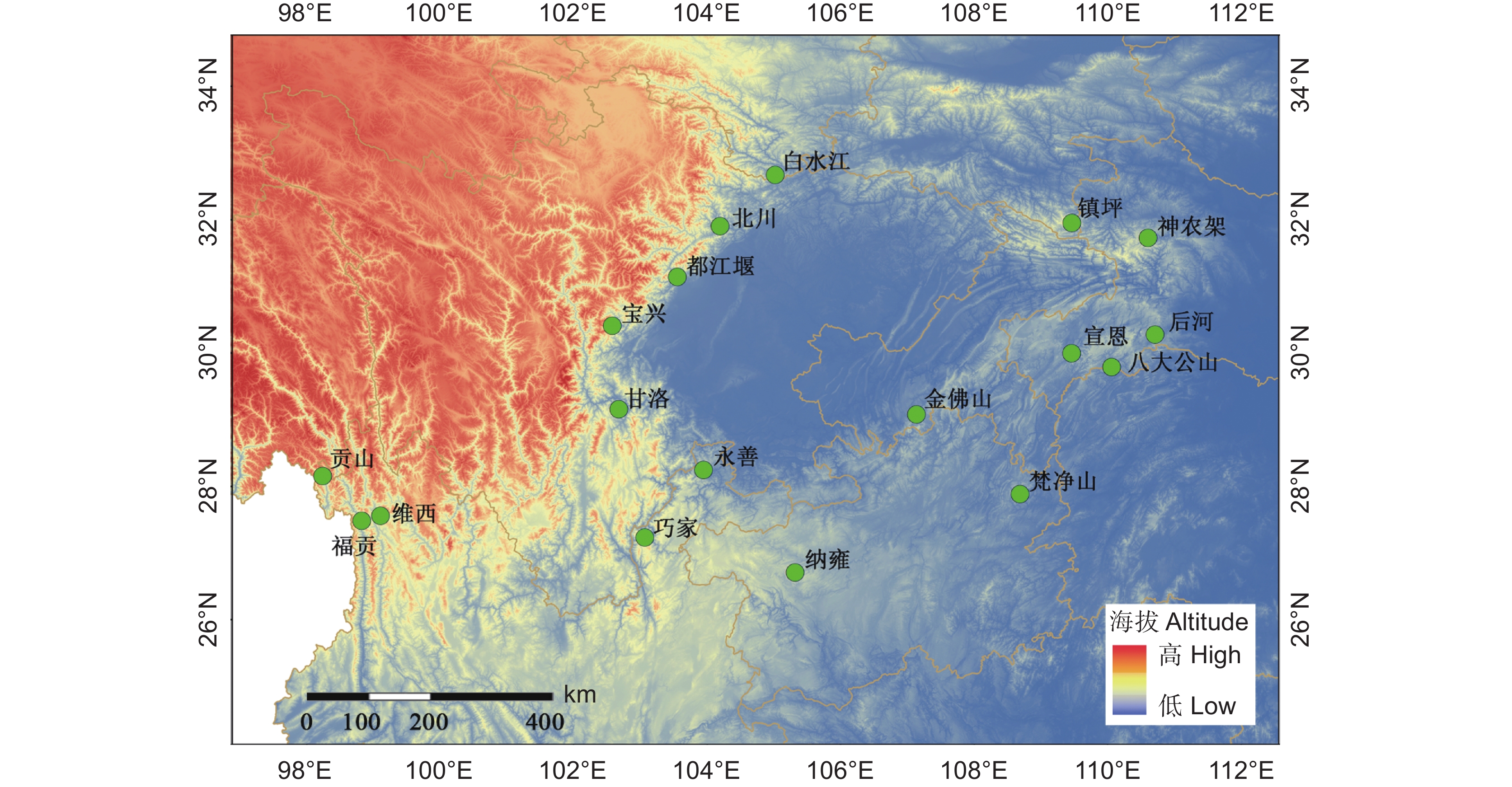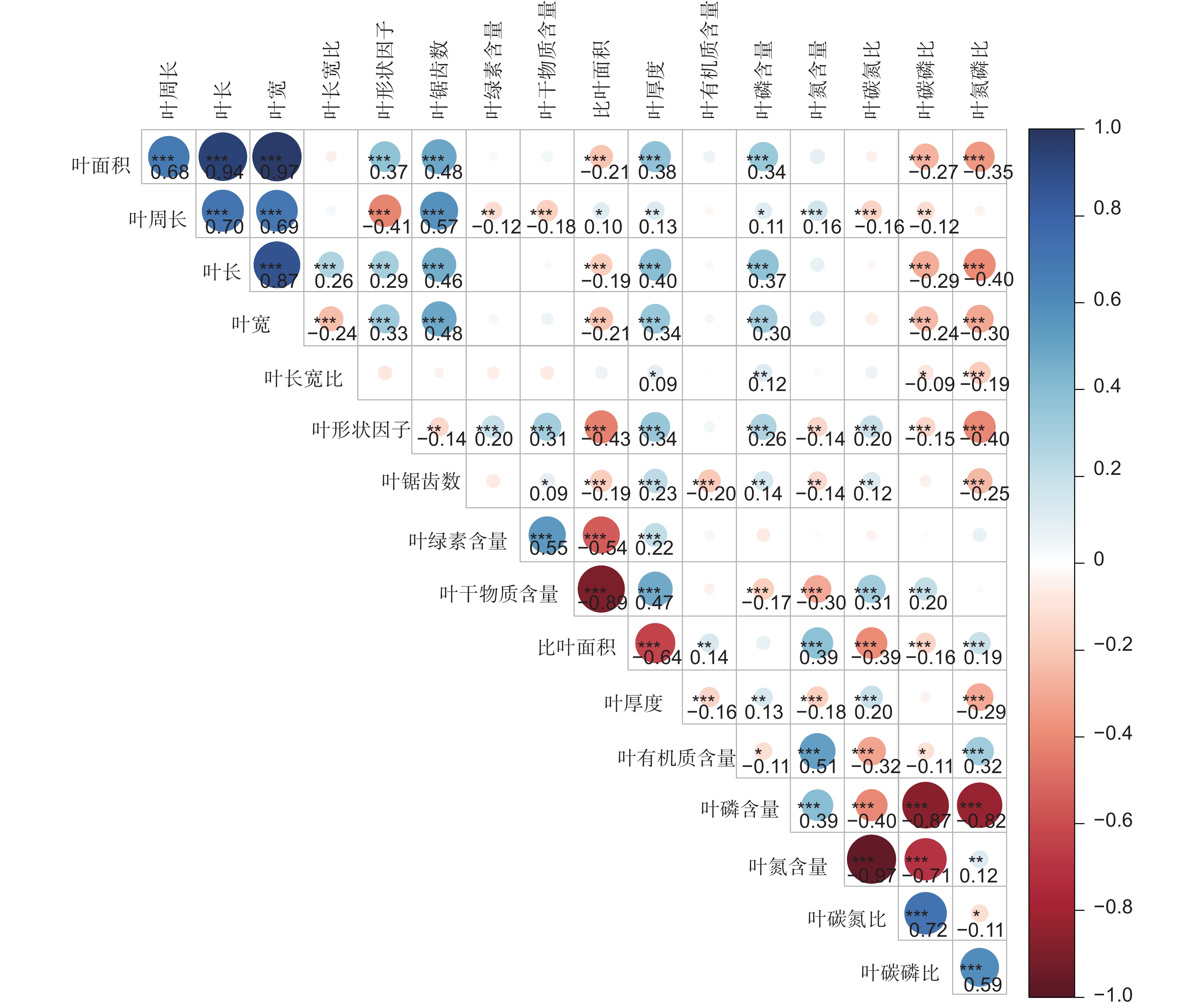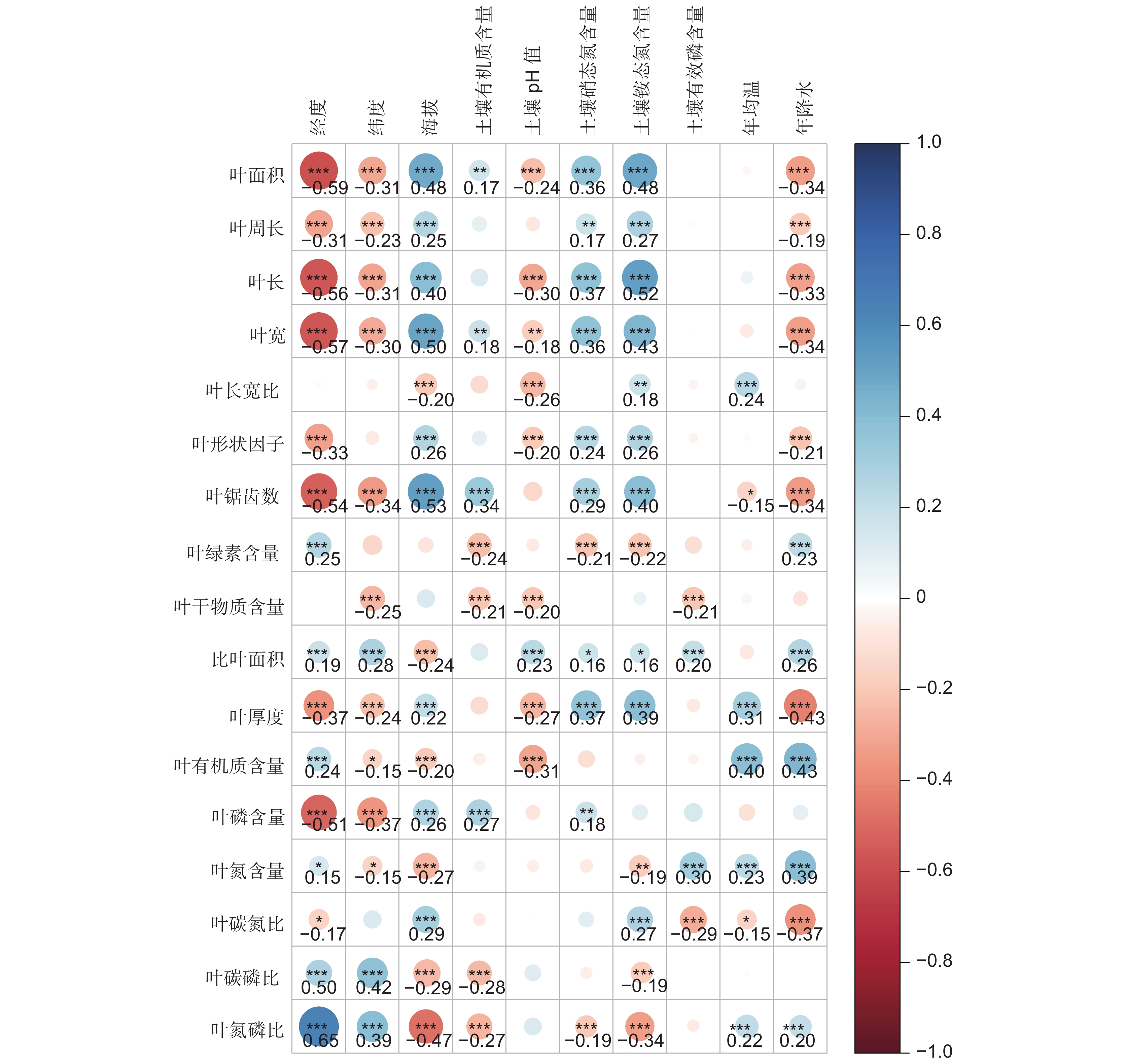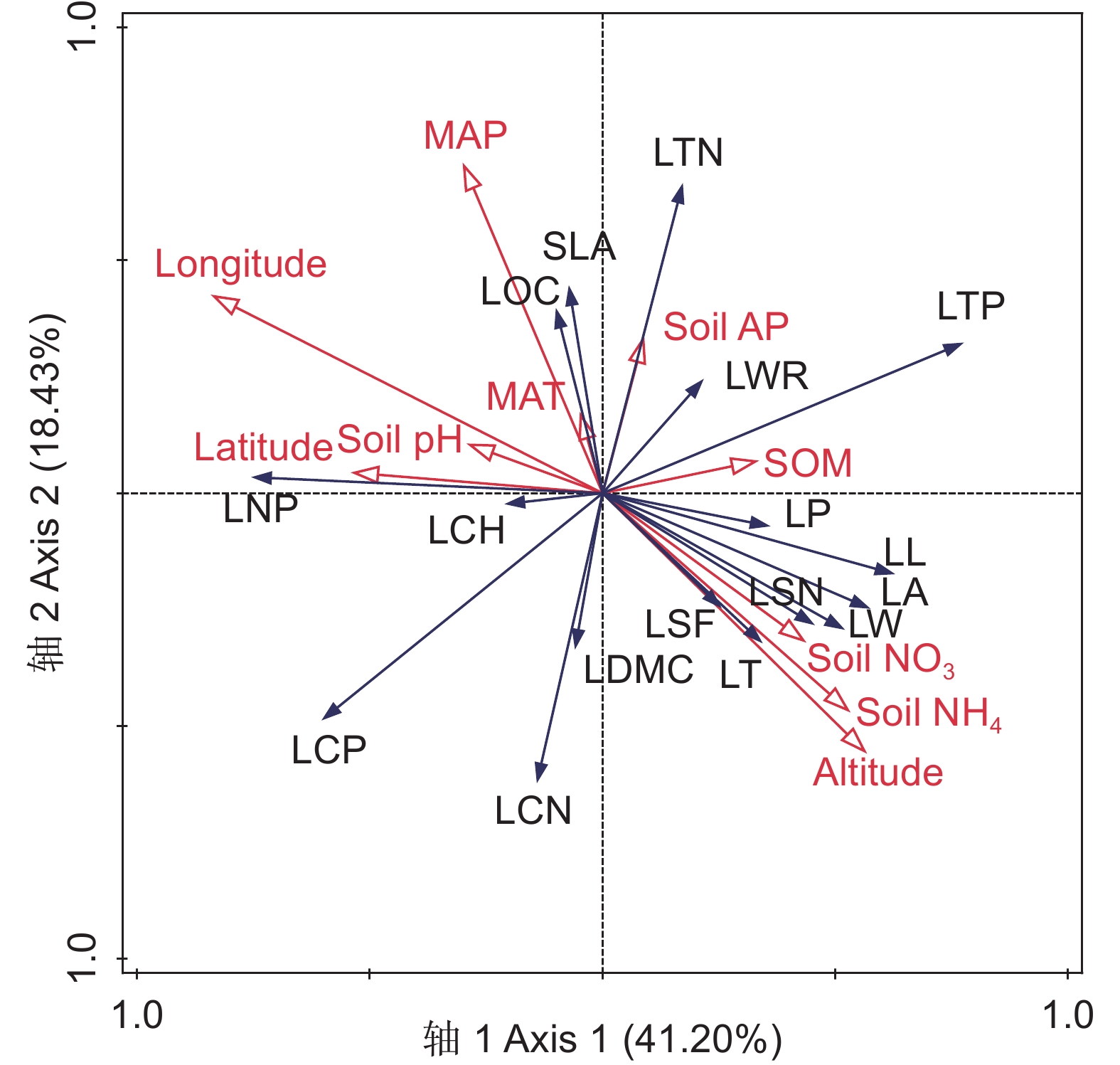Geographic patterns of leaf functional traits and environmental drivers of national key protected wild plant Davidia involucrata Baillon
-
摘要:
以国家重点保护植物珙桐(Davidia involucrata Baillon)为研究对象,对其分布区内18个种群的17项叶片功能性状进行测量,探究叶功能性状的地理格局与对异质环境的适应机制。结果显示,在局域尺度上,珙桐叶片功能性状变异系数介于1.48%~24.81%,其中,叶碳磷比变异程度最大,叶有机质含量变异最小。随着经度或纬度的增加,珙桐叶片叶锯齿数、叶面积、叶厚度显著降低。随着海拔的增加,珙桐叶片叶磷含量、叶面积、叶厚度、叶干物质含量显著增加,珙桐叶片形状变得更宽且更近于圆形。叶片边缘锯齿增强了珙桐叶片对于寒冷的适应性。环境因子解释了79.90%的珙桐叶片性状变异,该变异主要由地理变量与气候因子驱动,同时受到土壤因子的影响。年降水和土壤氮元素是叶片性状变异的最强解释因子,随着降水增加或者土壤氮元素减少,叶片变得小且薄。研究结果说明,珙桐叶片功能性状在物种分布区尺度上呈现出明显的地理格局,其中降水、土壤氮元素含量在地理格局的形成中发挥了重要的作用。
Abstract:The geographical patterns of plant functional traits and their environmental drivers remain central questions in plant population ecology. Leaf functional traits can directly affect the physiological and biochemical processes of plants, reflecting resource acquisition strategies and adaptation mechanisms. In this paper, we measured 17 functional traits of 18 populations of the national key protected wild plant Davidia involucrata Baillon across its natural distribution range in China, and analyzed the geographical patterns of leaf functional traits and their adaptation mechanisms to heterogeneous environments. At the local scale, the coefficients of variation of leaf traits ranged from 1.48% to 24.81%. The variation degree in the leaf carbon phosphorus ratio was the largest, while the variation degree of leaf organic carbon content was the smallest. With increasing longitude and latitude, leaf area, thickness, and serration number decreased significantly. With increasing altitude, leaf thickness, dry matter content, area, and phosphorus content increased significantly, while leaf shape became wider and rounder. Leaf serration enhanced the adaptability of D. involucrata leaves to cold. Significant leaf trait-geography correlations were mediated by climatic and/or soil factors. Environmental factors explained 79.90% of the variation in D. involucrata leaf traits, with variation of leaf traits mainly driven by geographical variables, climatic factors, and soil factors. Annual precipitation and soil nitrogen content were the strongest explanatory factors for leaf trait variation, with increasing precipitation or decreasing soil nitrogen leading to smaller and thinner leaves. In general, the functional traits of D. involucrata leaves showed a clear pattern at the species distribution scale, with precipitation and soil nitrogen content playing an important role in the formation of geographical patterns.
-
Keywords:
- Davidia involucrata /
- Leaf traits /
- Environmental factors /
- Phenotypic variation /
- Protected plant
-
1 如需查阅附表内容请登录《植物科学学报》网站(http://www.plantscience.cn)查看本期文章。 -
图 4 珙桐叶功能性状与环境因子的冗余分析
MAT:年均温; MAP:年降水; SOM:土壤有机质含量; Soil AP:土壤有效磷含量; Soil NO3:土壤硝态氮含量; Soil NH4:土壤铵态氮含量。其余简写参考表1。
Figure 4. Redundancy analysis of functional traits and environmental factors in D. involucrata leaves
MAT: Mean annual temperature; MAP: Mean annual precipitation; SOM: Soil organic matter; Soil AP: Soil available phosphorus content; Soil NO3: Soil nitrate nitrogen content; Soil NH4: Soil ammonium nitrogen content. Abbreviations of leaf functional traits are shown in Table 1.
表 1 珙桐叶片功能性状的变异系数
Table 1 Leaf trait variations in Davidia involucrata
性状
Trait最大值
Maximum最小值
Minimum平均值
Mean value倍数
Fold局域变异系数
Local CV / %区域变异系数
Regional CV / %叶面积LA / cm2 199.86 50.36 107.01 3.97 15.91 14.66 叶周长LP / cm 92.83 45.57 64.31 2.04 6.27 8.83 叶长LL / cm 20.23 10.46 14.97 1.93 7.82 7.41 叶宽LW / cm 15.19 7.41 10.94 2.05 7.84 7.58 叶长宽比LWR 1.70 1.19 1.38 1.43 3.67 4.30 叶形状因子LSF 0.61 0.18 0.33 3.36 11.54 12.63 叶锯齿数LSN 134.23 29.80 80.78 4.50 11.60 11.45 叶绿素含量LCH(SPAD) 50.52 23.72 38.10 2.13 6.83 9.01 叶干物质含量LDMC / mg/g 393.26 172.11 270.98 2.28 9.36 10.55 比叶面积SLA / m2/kg 58.99 12.37 28.55 4.77 21.07 18.64 叶厚度LT / mm 0.32 0.11 0.21 3.02 13.23 10.18 叶有机质含量LOC / mg/g 467.54 440.36 450.42 1.06 1.48 2.02 叶磷含量LTP / mg/g 3.43 1.34 1.88 2.56 24.39 15.90 叶氮含量LTN / mg/g 36.10 22.23 28.67 1.62 11.05 9.93 叶碳氮比LCN 20.39 12.95 15.89 1.57 10.49 9.93 叶碳磷比LCP 13.00 4.16 8.92 3.13 24.81 15.50 叶氮磷比LNP 21.04 9.05 15.82 2.33 17.73 13.29 注:区域变异系数为所有采样点性状变异系数平均值;局域变异系数为各采样点内平均性状的变异系数。CV:变异系数;LA:叶面积; LP:叶周长; LL:叶长; LW:叶宽; LWR:叶长宽比; LSF:叶形状因子; LSN:叶锯齿数; LCH:叶绿素含量; LDMC:叶干物质含量; SLA:比叶面积; LT:叶片厚度; LOC:叶有机质含量; LTP:叶磷含量; LTN:叶氮含量; LCN:叶碳氮比; LCP:叶碳磷比; LNP:叶氮磷比。 Notes: Regional trait CV, CV of mean trait values in each site; Local trait CV, average trait CV of within site leaf samples. CV: Coefficient of variation; LA: Leaf area; LP: Leaf perimeter; LL: Leaf length; LW: Leaf width; LWR: Length/width; LSF: Leaf shape factor; LSN: Leaf serration number; LCH: Leaf chlorophyll content; LDMC: Leaf dry matter content; SLA: Specific leaf area; LT: Leaf thickness; LOC: Leaf organic carbon content; LTP: Leaf phosphorus content; LTN: Leaf nitrogen content; LCN: Leaf organic carbon/nitrogen content; LCP: Leaf organic carbon/phosphorus content; LNP: Leaf nitrogen/phosphorus content. -
[1] Dı́az S,Cabido M. Vive la différence:plant functional diversity matters to ecosystem processes[J]. Trends Ecol Evol,2001,16(11):646−655. doi: 10.1016/S0169-5347(01)02283-2
[2] 李耀琪,王志恒. 植物叶片形态的生态功能、地理分布与成因[J]. 植物生态学报,2021,45(10):1154−1172. doi: 10.17521/cjpe.2020.0405 Li YQ,Wang ZH. Leaf morphological traits:ecological function,geographic distribution and drivers[J]. Chinese Journal of Plant Ecology,2021,45(10):1154−1172. doi: 10.17521/cjpe.2020.0405
[3] Garnier E,Navas ML. A trait-based approach to comparative functional plant ecology:concepts,methods and applications for agroecology. A review[J]. Agron Sustain Dev,2012,32(2):365−399. doi: 10.1007/s13593-011-0036-y
[4] Moles AT,Perkins SE,Laffan SW,Flores-Moreno H,Awasthy M,et al. Which is a better predictor of plant traits:temperature or precipitation?[J]. J Veg Sci,2014,25(5):1167−1180. doi: 10.1111/jvs.12190
[5] Meng H,Wei X,Franklin SB,Wu H,Jiang M. Geographical variation and the role of climate in leaf traits of a relict tree species across its distribution in China[J]. Plant Biol,2017,19(4):552−561. doi: 10.1111/plb.12564
[6] Tian D,Yan ZB,Niklas KJ,Han WX,Kattge J,et al. Global leaf nitrogen and phosphorus stoichiometry and their scaling exponent[J]. Natl Sci Rev,2018,5(5):728−739. doi: 10.1093/nsr/nwx142
[7] 何雅琴,史晓洁,陈国杰,赖敏英,曾纪毅,等. 滨柃叶功能性状对环境因子的响应[J]. 生态学报,2022,42(6):2418−2429. He YQ,Shi XJ,Chen GJ,Lai MY,Zeng JY,et al. Response and adaptation of leaf functional traits of Eurya emarginata to environmental factors[J]. Acta Ecologica Sinica,2022,42(6):2418−2429.
[8] Wright IJ,Dong N,Maire V,Prentice IC,Westoby M,et al. Global climatic drivers of leaf size[J]. Science,2017,357(6354):917−921. doi: 10.1126/science.aal4760
[9] Wang CG,He JM,Zhao TH,Cao Y,Wang GJ,et al. The smaller the leaf is,the faster the leaf water loses in a temperate forest[J]. Front Plant Sci,2019,10:58. doi: 10.3389/fpls.2019.00058
[10] Li YQ,Reich PB,Schmid B,Shrestha N,Feng X,et al. Leaf size of woody dicots predicts ecosystem primary productivity[J]. Ecol Lett,2020,23(6):1003−1013. doi: 10.1111/ele.13503
[11] Guerin GR,Wen HX,Lowe AJ. Leaf morphology shift linked to climate change[J]. Biol Lett,2012,8(5):882−886. doi: 10.1098/rsbl.2012.0458
[12] Zhang L,Luo TX,Liu XS,Wang Y. Altitudinal variation in leaf construction cost and energy content of Bergenia purpurascens[J]. Acta Oecol,2012,43:72−79. doi: 10.1016/j.actao.2012.05.011
[13] Cornwell WK,Ackerly DD. Community assembly and shifts in plant trait distributions across an environmental gradient in coastal California[J]. Ecol Monogr,2009,79(1):109−126. doi: 10.1890/07-1134.1
[14] 王瑞丽,于贵瑞,何念鹏,王秋凤,赵宁,徐志伟. 中国森林叶片功能属性的纬度格局及其影响因素[J]. 地理学报,2015,70(11):1735−1746. doi: 10.11821/dlxb201511004 Wang RL,Yu GR,He NP,Wang QF,Zhao N,Xu ZW. Latitudinal patterns and influencing factors of leaf functional traits in Chinese forest ecosystems[J]. Acta Geographica Sinica,2015,70(11):1735−1746. doi: 10.11821/dlxb201511004
[15] Kattge J,Díaz S,Lavorel S,Prentice IC,Leadley P,et al. TRY-a global database of plant traits[J]. Glob Chang Biol,2011,17(9):2905−2935. doi: 10.1111/j.1365-2486.2011.02451.x
[16] Siefert A,Violle C,Chalmandrier L,Albert CH,Taudiere A,et al. A global meta-analysis of the relative extent of intraspecific trait variation in plant communities[J]. Ecol Lett,2015,18(12):1406−1419. doi: 10.1111/ele.12508
[17] Zhou W,Wang ZX,Davy AJ,Liu GH. Geographic variation and local adaptation in Oryza rufipogon across its climatic range in China[J]. J Ecol,2013,101(6):1498−1508. doi: 10.1111/1365-2745.12143
[18] Siefert A. Incorporating intraspecific variation in tests of trait-based community assembly[J]. Oecologia,2012,170(3):767−775. doi: 10.1007/s00442-012-2351-7
[19] Breza LC,Souza L,Sanders NJ,Classen AT. Within and between population variation in plant traits predicts ecosystem functions associated with a dominant plant species[J]. Ecol Evol,2012,2(6):1151−1161. doi: 10.1002/ece3.223
[20] Albert CH,de Bello F,Boulangeat I,Pellet G,Lavorel S,Thuiller W. On the importance of intraspecific variability for the quantification of functional diversity[J]. Oikos,2012,121(1):116−126. doi: 10.1111/j.1600-0706.2011.19672.x
[21] Albert CH,Thuiller W,Yoccoz NG,Soudant A,Boucher F,et al. Intraspecific functional variability:extent,structure and sources of variation[J]. J Ecol,2010,98(3):604−613. doi: 10.1111/j.1365-2745.2010.01651.x
[22] 中国科学院中国植物志编辑委员会. 中国植物志[M]. 北京: 科学出版社, 1983, 52(2): 157. [23] Chen Y,Ma T,Zhang LS,Kang MH,Zhang ZY,et al. Genomic analyses of a “living fossil”:the endangered dove-tree[J]. Mol Ecol Resour,2020,20(3):756−769. doi: 10.1111/1755-0998.13138
[24] Tang CQ,Matsui T,Ohashi H,Dong YF,Momohara A,et al. Identifying long-term stable refugia for relict plant species in East Asia[J]. Nat Commun,2018,9(1):4488. doi: 10.1038/s41467-018-06837-3
[25] 张潇月,周润惠,余飞燕,叶鑫,王敏,等. 大相岭自然保护区珙桐群落植物区系、结构及动态[J]. 生态学杂志,2020,39(5):1509−1517. Zhang XY,Zhou RH,Yu FY,Ye X,Wang M,et al. Flora,structure,and dynamics of Davidia involucrata community in Daxiangling Nature Reserve[J]. Chinese Journal of Ecology,2020,39(5):1509−1517.
[26] 刘海洋,金晓玲,沈守云,张日清. 湖南珍稀濒危植物——珙桐种群数量动态[J]. 生态学报,2012,32(24):7738−7746. doi: 10.5846/stxb201203270425 Liu HY,Jin XL,Shen SY,Zhang RQ. Population quantitative characteristics and dynamics of rare and endangered plant Davidia involucrata in Hunan province[J]. Acta Ecologica Sinica,2012,32(24):7738−7746. doi: 10.5846/stxb201203270425
[27] 刘婷婷,刘沁松,徐文娟,徐治兵,李中阳,等. 珙桐(Davidia involucrata Baill. )苞片功能性状及性状间关系对海拔的响应[J]. 生态学杂志,2020,39(3):794−802. Liu TT,Liu QS,Xu WJ,Xu ZB,Li ZY,et al. Altitudinal changes of functional traits and relationships among traits of bracts in dove tree (Davidia involucrata Baill.)[J]. Chinese Journal of Ecology,2020,39(3):794−802.
[28] Chen JM,Zhao SY,Liao YY,Gichira AW,Gituru RW,Wang QF. Chloroplast DNA phylogeographic analysis reveals significant spatial genetic structure of the relictual tree Davidia involucrata(Davidiaceae)[J]. Conserv Genet,2015,16(3):583−593. doi: 10.1007/s10592-014-0683-z
[29] 牛文娟,张涛,邓东周,庄文化. 珙桐繁殖技术及生长发育研究进展[J]. 植物生理学报,2013,49(10):1018−1022. Niu WJ,Zhang T,Deng DZ,Zhuang WH. A review on reproductive technology and growing of Davidia involucrata Baill.[J]. Plant Physiology Journal,2013,49(10):1018−1022.
[30] 张腾驹,陈小红,康喜坤,刘静. 四川省珙桐天然种群叶表型多样性[J]. 生态学杂志,2019,38(1):35−43. Zhang TJ,Chen XH,Kang XK,Liu J. Phenotypic diversity of leaf morphologic traits of Davidia involucrata natural populations in Sichuan province[J]. Chinese Journal of Ecology,2019,38(1):35−43.
[31] 陈艳,苏智先. 中国珍稀濒危孑遗植物珙桐种群的保护[J]. 生态学报,2011,31(19):5466−5474. Chen Y,Su ZX. Research on the protection of Davidia involucrata populations,a rare and endangered plant endemic to China[J]. Acta Ecologica Sinica,2011,31(19):5466−5474.
[32] Fick SE,Hijmans RJ. WorldClim 2:new 1-km spatial resolution climate surfaces for global land areas[J]. Int J Climatol,2017,37(12):4302−4315. doi: 10.1002/joc.5086
[33] Craine JM,Ocheltree TW,Nippert JB,Towne EG,Skibbe AM,et al. Global diversity of drought tolerance and grassland climate-change resilience[J]. Nat Clim Change,2013,3(1):63−67. doi: 10.1038/nclimate1634
[34] Dong N,Prentice IC,Wright IJ,Evans BJ,Togashi HF,et al. Components of leaf-trait variation along environmental gradients[J]. New Phytol,2020,228(1):82−94. doi: 10.1111/nph.16558
[35] Chapin III FS,Schulze E,Mooney HA. The ecology and economics of storage in plants[J]. Annu Rev Ecol Evol Syst,1990,21:423−447. doi: 10.1146/annurev.es.21.110190.002231
[36] Ordoñez JC,van Bodegom PM,Witte JPM,Wright IJ,Reich PB,Aerts R. A global study of relationships between leaf traits,climate and soil measures of nutrient fertility[J]. Glob Ecol Biogeogr,2009,18(2):137−149. doi: 10.1111/j.1466-8238.2008.00441.x
[37] Reich PB,Oleksyn J. Global patterns of plant leaf N and P in relation to temperature and latitude[J]. Proc Natl Acad Sci USA,2004,101(30):11001−11006. doi: 10.1073/pnas.0403588101
[38] Maire V,Wright IJ,Prentice IC,Batjes NH,Bhaskar R,et al. Global effects of soil and climate on leaf photosynthetic traits and rates[J]. Glob Ecol Biogeogr,2015,24(6):706−717. doi: 10.1111/geb.12296
[39] Niklas KJ. Plant allometry,leaf nitrogen and phosphorus stoichiometry,and interspecific trends in annual growth rates[J]. Ann Bot,2006,97(2):155−163. doi: 10.1093/aob/mcj021
[40] Feild TS,Sage TL,Czerniak C,Iles WJD. Hydathodal leaf teeth of Chloranthus japonicus(Chloranthaceae) prevent guttation-induced flooding of the mesophyll[J]. Plant,Cell Environ,2005,28(9):1179−1190.
[41] Peppe DJ,Royer DL,Cariglino B,Oliver SY,Newman S,et al. Sensitivity of leaf size and shape to climate:global patterns and paleoclimatic applications[J]. New Phytol,2011,190(3):724−739. doi: 10.1111/j.1469-8137.2010.03615.x
[42] Reich PB,Oleksyn J,Wright IJ. Leaf phosphorus influences the photosynthesis-nitrogen relation:a cross-biome analysis of 314 species[J]. Oecologia,2009,160(2):207−212. doi: 10.1007/s00442-009-1291-3
[43] Fonseca CR,Overton JM,Collins B,Westoby M. Shifts in trait-combinations along rainfall and phosphorus gradients[J]. J Ecol,2000,88(6):964−977. doi: 10.1046/j.1365-2745.2000.00506.x
[44] Midolo G,de Frenne P,Hölzel N,Wellstein C. Global patterns of intraspecific leaf trait responses to elevation[J]. Glob Chang Biol,2019,25(7):2485−2498. doi: 10.1111/gcb.14646
[45] Umaña MN,Swenson NG. Intraspecific variation in traits and tree growth along an elevational gradient in a subtropical forest[J]. Oecologia,2019,191(1):153−164. doi: 10.1007/s00442-019-04453-6
[46] Li FL,Bao WK. Elevational trends in leaf size of Campylotropis polyantha in the arid Minjiang River valley,SW China[J]. J Arid Environ,2014,108:1−9. doi: 10.1016/j.jaridenv.2014.04.011
[47] Hu J,Hu H. Viewing leaf shape and size variation in tobacco plants under different temperatures from a hydraulic perspective[J]. Plant Diversity,2015,37(2):168−176.
[48] Li YQ,Zou DT,Shrestha N,Xu XT,Wang QG,et al. Spatiotemporal variation in leaf size and shape in response to climate[J]. J Plant Ecol,2020,13(1):87−96. doi: 10.1093/jpe/rtz053
[49] Ensslin A,Fischer M. Variation in life-history traits and their plasticities to elevational transplantation among seed families suggests potential for adaptative evolution of 15 tropical plant species to climate change[J]. Am J Bot,2015,102(8):1371−1379. doi: 10.3732/ajb.1400518




 下载:
下载:



